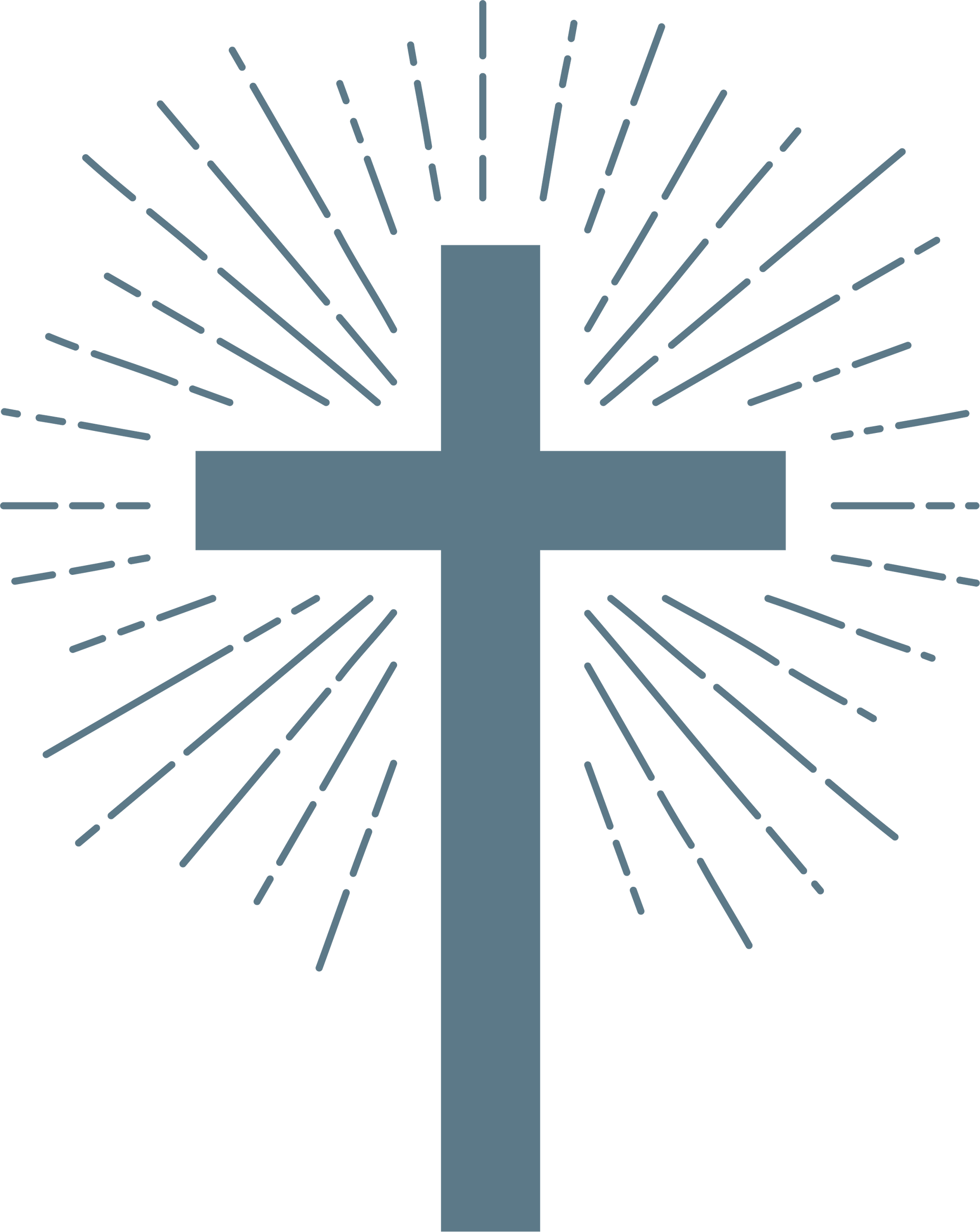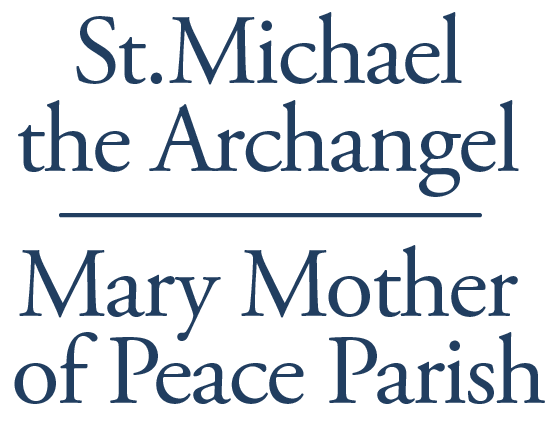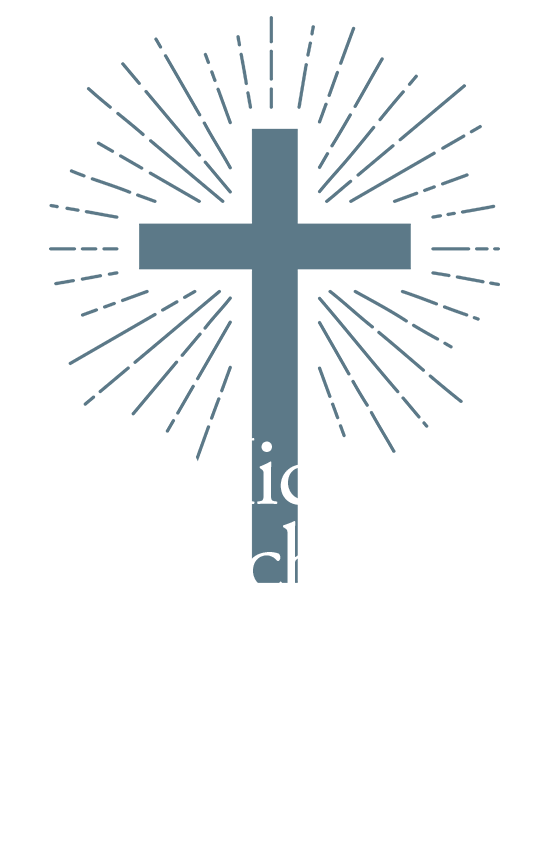History of our Church
History of our Church
Milestones:
- The Early Years - A Dream of the Church
- Groundwork for the Dream
- The Dream to Build a Church
- The Dream Becomes Reality
---------------------------------------------
taken from the 2007 Parish bulletins:
The Early Years - A Dream of the Church
The first bulletin of 2007 introduced a new feature, as St. Michael the Archangel began its 50th Anniversary year of celebration. Honoring Our Past . . . Building Our Future was a weekly presentation of some aspect of St. Michael’s history. Much of the information was taken from the church history compiled by a former parishioner, the late Klaus Abele, in 1977. The following accounts are directly from the published bulletins.
1890 – St. Michael’s roots go far deeper than the incorporation of the present church in 1957. In 1890, Fr. Thomas Waldron was appointed pastor of Holy Cross in Dover, with the responsibility to celebrate Mass at several locations in Milford, because there were no Catholic churches in southern Kent or Sussex counties.
Roman Catholicism was not a popular religion in this time and place, and was considered to be a radical sect. In Georgetown, the very few Catholic families were targeted by the Ku Klux Klan. Klan members were known to hide in bushes, and then come out to intimidate Catholics as they would attempt to go to Milford to church.
1909 – Despite its public perception as some type of “radical sect,” Roman Catholicism did grow in the years following 1890, when the late Father Thomas Waldron, pastor of Holy Cross in Dover, was given the responsibility to say Mass in various locations in Milford, for residents of southern Kent and Sussex counties. Twenty years later in 1909, property was purchased on Lake Street, Milford, so that a new church could be built.
1910 – One year later, St. John the Apostle was dedicated by the late Bishop John. J. Monaghan, as a mission church of Holy Cross. Bishop Monaghan died in 1935. The new mission church was to serve not only the City of Milford, but southern Kent County, and all of Sussex County.
1912 – Two years after its dedication, St. John the Apostle was made a separate parish. Bishop Monaghan named the late Fr. Michael Daugherty as pastor. To ensure that all the people of his parish could attend Mass, Fr. Daugherty and his associates also traveled to other locations in Harrington, Greenwood, Lewes, Bridgeville and Georgetown, according to information Mr. Abele learned in a May 1, 1977 interview with Fr. Leo Montgomery, who was the first pastor when St. Michael the Archangel was founded.
In addition to interview during the preparation of his 1977 church history, Mr. Abel also gathered information from other local historical sources, including an old book about Georgetown entitled, 16 miles from Anywhere, by William J. Wade.
1919 – According to Mr. Wade, there were only two Catholic families in the area at this time – Mr. and Mrs. John O’Connor and Mr. and Mrs. Frank McGuigan. During her 1977 interview, Ann Conway related that the late Fr. Francis Fitzpatrick celebrated Mass monthly in the McGuigan home, and Catholics from Harrington, Greenwood, Bridgeville and Lewes would attend. On other Sundays the McGuigans and the O’Connors would attend Mass in Milford or Lewes.
1920 – Eventually the McGuigans moved away from Georgetown, and Mass was celebrated in the O’Connor home. Then Mr. and Mrs. William A. Conway, Sr. and family came to Georgetown. Mass was then said in the Conway home, because it was located in the center of town, and the O’Connors lived on the outskirts. Fr. David Conway, presently retired, is the son of the elder Conways. He has moved back to Georgetown, and helps in our Parish.
It is interesting that at his time Mr. John O’Connor offered the Bishop, the late Most Rev. John Monaghan, a parcel of land along DuPont Hwy (now Swain Acres) for the purpose of building a church. However, Bishop Monaghan believed there was not yet enough need. The present-day St. Michael the Archangel is less than a mile from the land Mr. O’Connor originally offered.
1920–28 – The late Klaus Abele provides some background of the Conway family of Georgetown. The family, Mr. Abele says, was one of “very strict Catholic beliefs.” Mr. John Conway ensured that his own family, and any others who wished to travel, would attend Mass every Sunday. When Mass was not being said at his home, Mr. Conway would drive either to Milford or Rehoboth, each about 20 miles away.
Many times, Mr. Conway would take his family to the early Mass in Milford, and then drive anyone else who wanted to go to the later Mass in Rehoboth Beach. Mr. Abele credits Mr. Conway as being a very religious man, who “. . . was responsible for the growth of Catholicism in Georgetown.”
When the late Fr. Francis Fitzpatrick left St John’s, the late Fr. Joseph H. Irwin (later Monsignor) became pastor. Rev. Msgr. Irvin died in 1969. The late Fr. Charles L. Conway (later Monsignor) was named Associate Pastor. He passed away in 1972. Fr. Conway was a cousin of William Conway, Sr., of Georgetown. Mr. and Mrs. William Conway had two sons – one of whom was to become a Roman Catholic priest – Fr. David Conway, now retired from the Washington, D.C. area, living in Georgetown, and assisting our parish.
1929–1941 – Mr. Abele writes about a very low period in the growth of Catholicism throughout the decade of the 1930’s until the onset of World War II. When the late Fr. Charles Conway left St. John’s in Milford, he was replaced by the late Fr. Alfred Jones. Fr. Jones was appointed pastor, but later died in 1937.
It was during this period, Mr. Abele says, that “. . . the energy of Catholicism sort of moved away. Without the family’s strong leadership, Mr. Abele asserts, Catholic enthusiasm “. . . dropped off drastically.”
Groundwork for the Dream
1942-1947 – Mr. Abele writes that the onset of World War II actually had a positive effect on the growth of Catholicism in Georgetown, following the low period of the Depression era of the 1930’s.
From his 1977 interview with Ann Conway, Mr. Abele writes about Georgetown becoming a training site for Army soldiers stationed here from many parts of the country. Many of these soldiers and their families were Catholic.
Fortunately, the Army Chaplain here was kind enough to allow local Catholics to attend Mass with the Military. Mass was said first at the Civilian Conservation Corps (CCC), and later at the Armory on West Pine Street. This was a wonderful incentive to Georgetown Catholics, because gas was severely rationed during the war years, and most people could not afford to drive to Milford or even Rehoboth to attend Mass.
Mr. Abele notes that the late Fr. Clement Falter, one of the chaplains stationed in Georgetown during this time, would later become the first American chaplain to be killed in World War II.
1948-1949 – Mr. Abele continues his 1977 history of St. Michael the Archangel by describing the early post-World War II period, based on his interview with Ann Conway.
At this time, the late Fr. Andrew J. White, who died on Valentine’s Day in 1964, was assigned to St. John’s in Milford. However, in the late 1940’s, Catholicism in Georgetown was growing very quickly, due to the general increase in population and growth in industry.
Nevertheless, it was still very hard for Georgetown Catholics to arrange transportation to either Milford or Rehoboth Beach for Mass every Sunday. Therefore, two local Catholic leaders, Mr. Fred Goggin and Mr. Joseph Superka, took it upon themselves to ask Fr. White if he would say Mass in Georgetown.
Fr. White decided to determine if there was a need; so a survey was done to find out how many would attend, if Mass was held in Georgetown. Although the number count from the survey is not known, it was decided that sufficient need was present. On June 19, 1949, Fr. White offered Mass in the American Legion Hall.
1949-1951 – Mr. Abele continues his account of the beginnings of Mass being said on regular basis in Georgetown. Based on his interview with Ann Conway, Mr. Abele notes that Mass continued to be said at the American Legion Hall through September 1949. On October 1, the location was changed to the Veterans of Foreign Wars (VFW) hall, where it remained for several years.
Faithful Catholics worked hard to make the VFW into their “church.” The men built an altar, and VFW members donated chairs. Other Catholics gave gifts. Anthony Pizzutto provided kneelers; Nicholas Varato donated carpet for around the altar; and Mr. and Mrs. Facanty Obzut gave gold candlesticks.
Still other Catholics such as Mrs. Fred Goggin organized a choir. Miss Eva Marie Kalier and Edward Turnberger trained altar servers. There even were religious education classes set up after Mass, so that Catholic children of Georgetown would be trained in the faith.
The Dream to Build a Church
1952-1954 – Mr. Abele comments that all the efforts made to turn the VFW hall into a church left only one more step to be taken – to build an actual church in Georgetown, and thereby fulfill the dream so many local Catholics had carried in their hearts for so long.
Fr. Andrew White began the process when he bought a small parcel of land on East Market Street, across from the old Dodd Funeral Home, now Short’s. However, before anything else could be done, Fr. White was transferred, and once again the dream’s fulfillment was delayed.
Replacing Fr. Andrew White in 1952 was the late Rev. Msgr. Francis Desmond, who passed away on November 4, 1980.
Fr. Desmond knew that to make the dream of a Catholic church in Georgetown a reality, the local faithful would have to become a committed and cohesive unit. Much money would be needed to be raised to undertake such a project, and public awareness heightened.
To begin this process, Fr. Desmond organized three groups. The first was for the women – the Blessed Virgin Mary Sodality, which was led by Ann Conway. For the men, a Holy Name Society was formed, and a Knights of Columbus group, which was a forerunner of Bishop Burke Council 11285 active in the parish today. Members of these groups were to become the lay leadership for the large fundraising project yet to come.
1954 – Mr. Abele comments on the events leading up to ground breaking for the new church. In an interview with the late Fr. Leo F. Montgomery, Mr. Abele learned how the present site of St. Michael the Archangel was acquired. Fr. Montgomery was later to become the first pastor at St. Michael’s; he died on November 27, 1996.
According to Fr. Montgomery, Fr. Francis Desmond (later Msgr.) became concerned that the land on East Market Street, previously purchased by Fr. Andrew White, in fact would be too small on which to build a church large enough to serve the growing Catholic community in Georgetown, and so he sold the land to Mr. Fred Goggin, one of the local faithful involved very early in the efforts to have Mass said here.
Fr. Desmond then bought a six-acre tract on Edward Street, on the northwest side of Georgetown, where the present church stands. Fr. Desmond purchased the land from the late U.S. Senator John J. Williams, of Millsboro, for whom Rt. 24 is named as John J. Williams Highway.
1954-55 – Mr. Abele describes the activity generated by the approaching reality of building a Catholic church in Georgetown.
The purchase of land on Edward Street by the late Fr. Francis Desmond encouraged an upswing in efforts by local Catholics to raise money for the church as quickly as possible, Mr. Abele relates. There were nearly continuous bake and rummage sales, bazaars, dinners and dances.
There even was a large concert given by the St. Francis de Sales church choir from Salisbury, MD, under the direction of the late Rev. Msgr. Eugene T. Stout, who died on February 23, 1977. The whole choir’s time and talent were generously donated to the new church’s building fund.
1955 – Mr. Abele continues his narrative of the 1977 history of St. Michael the Archangel, by describing the church’s ground-breaking.
Following years of time and effort, the work of many dedicated parishioners finally came to fruition, Mr. Abele says. Approximately 300 people from throughout Delaware attended a ground-breaking ceremony at the Edward Street site, on October 23, 1955.
According to information supplied by the first pastor, Fr. Leo F. Montgomery, an architect, George McDermott, of Wilmington, was chosen to design the new church. T. J. O’Connel, also from Wilmington, was awarded the construction contract. Mr. O’Connel was present for the ground-breaking ceremony.
1955–1956 – Mr. Abele continued his narrative about church construction, following the ground-breaking ceremony held on October 23, 1955.
The raising of the church went “smoothly and swiftly,” Mr. Abele says. The rear section of the building (the hall) was erected first. Once the walls on the hall were up, construction workers began raising the massive pre-formed beams that would serve as the structural “backbone” of the church, also complementing its interior after completion.
Once the wooden beams were in place, walls of red brick were raised to cover the structural skeleton. The church rapidly was nearing completion. By June 1956, the church’s exterior was almost finished, but there still remained the task of outfitting the interior.
1956 – Following of the construction of St. Michael the Archangel, Mr. Abele describes how the interior was outfitted. For the most part, parishioners took on the task, with the most critical elements being donated in memory of a deceased one.
Mr. and Mrs. Lloyd Short donated the main altar, in memory of Mrs. Agnes Conway. The Blessed Mother altar was given by Mr. and Mrs. Lynn C. Brown, in memory of Mrs. Brown’s parents – Oswald and Theresa Steiner. Deceased members of the O’Connor and Holland families were honored by a donation of the tabernacle by Mr. and Mrs. Dewey Holland.
Many other parishioners and organizations helped with other items.
1956 – In his chronicling of the interior outfitting, following the construction of St. Michael the Archangel, Mr. Abele continues with details about additional donations from parishioners.
A ciborium in memory of Mary R. Conway was donated by Nellie Leathy. Nicholas Varrato gave a set of vestments in memory of Eva Varrato and Mr. and Mrs. Anthony Molinaro. Two pairs of gold vases from Nellie Leathy were given in memory of Earl and Michael Leathy.
The women of the Blessed Mary Sodality as a group contributed the organ that was to provide music for churchgoers for eight years. Countless other financial contributions were received, covering expenses such as pews and carpeting for the altar.
The Dream Becomes Reality
1956 – Mr. Abele writes about preparations for the dedication of St. Michael the Archangel in his 1977 history. After the celebration of the first Mass on August 15, the new parish was advised to prepare for Most Rev. Edmond J. Fitz Maurice, who passed away on July 25, 1962, to preside at a dedication Mass on October 28.
However, before the dedication could take place, parishioners were faced with yet another challenge. With preparations made, the parish was then informed that Bishop Fitz Maurice was ill, and would not be able to preside.
The date then was changed to December 2. Finally, St. Michael’s was dedicated on that date, and dreams of Georgetown’s faithful were fulfilled at last.
From the original two Catholic families who were in Georgetown in 1919, the Catholic population now had grown to 80 families in 1956. At last, it was time to name a pastor for the new parish.
1957-1963 – Mr. Abele writes about the naming of the new parish’s first pastor, and his accomplishments.
Most Rev. Edmond J. Fitz Maurice named as pastor Rev. Leo F. Montgomery, who was to serve until 1963. (Fr. Montgomery died on November 27, 1996.)
During his 1977 interview with Fr. Montgomery, Mr. Abele learned that the new pastor was living at the St. Edmond’s rectory in RehobothBeach. He soon arranged to purchase a house to serve as a rectory for the new parish. Mr. John Wardel agreed to sell to St. Michael’s a red brick house, immediately adjacent to the church lot.
Once he had moved in, Fr. Montgomery saw that the field which surrounded the church property was not complimentary to the new church. It was overrun with weeds in the summer, and became a dust bowl in the winter.
Fr. Montgomery then made arrangements to buy the land from the same U.S. Senator John J. Williams, of Millsboro, who previously sold the land for the new church. For many years, the church leased the land to area farmers, who kept it planted and maintained.
1957-1963 – Mr. Abele gives further details from his interview with the new parish’s first pastor, Fr. Leo F. Montgomery. In addition to purchasing a rectory and the land surrounding the church, Fr. Montgomery made the first provisions for children’s religious education.
The first formal program, then known as CCD (Confraternity of Christian Doctrine), was organized using parent volunteers. Classes were held on Sundays after Mass, as they still are today. Fr. Montgomery made arrangements for the parents to receive their training as catechists at St. John’s in Milford.
At this time, there also was a Catholic School at St. Edmond’s in Rehoboth Beach, but no transportation was available from Georgetown. To resolve this difficulty, Fr. Montgomery was able to have the parish purchase a used school bus, and he hired William Robb to drive it.
For a very small fee, Mr. Robb would drive the children from St. Michael’s to St. Edmond’s each morning, and make the return trip in the afternoon. This service continued until the school was closed in 1970, due to lack of nuns.
Fr. Montgomery stayed at St. Michael’s until 1963, when he was reassigned.
1963-1970 – Mr. Abele describes the mid-to-late 1960’s as an active and productive period for the new parish.
When the first pastor, the late Rev. Leo F. Montgomery, was reassigned in 1963, he was replaced by Rev. Paul J. Fallers, who passed away on August 1, 1982. Parish enrollment grew, and a new organ was purchased in 1964. Fr. Fallers’ assignment here lasted through 1965.
The new pastor was the Rev. George V. Rhodes, whose tenure here was from 1966-1970. Fr. Rhodes is now retired and lives at Vianney House in Wilmington. While he was here, a public address system was added to the church, and improvements to the hall were made.
1971-1973 – Mr. Abele describes the early 1970’s as a time of continued reassignment of pastors, and of beginning attempts to establish a youth ministry.
In January, 1971, the Rev. John Flynn, who passed away in the 1990’s, became pastor at St. Michael’s. He was a Maryknoll missionary, who had spent considerable time working in Mexico. (Fr. Flynn.)
It was Fr. Flynn’s goal to excite parishioners about their religion. He was a very dynamic preacher. Although he was at St. Michael’s for only five months, he raised parishioners’ awareness about the importance of Bible study, and the charismatic movement. Following Fr. Flynn’s mid-year reassignment, parishioners were pleased to welcome back their first pastor, the Rev. Leo F. Montgomery.
The closure of the school at St. Edmond’s in 1970 left St. Michael’s without a youth ministry. An early attempt to remedy that situation was the formation of a Christian Youth Organization (CYO), for youths 15-20 to gather for discussions of their faith, and for recreational activities like bowling and roller skating. Unfortunately, the group dissolved two years later due to lack of membership. Another attempt would not be made until 1974.
1974 – Mr. Abele details the efforts of one lay person to reorganize a youth ministry for the parish.
Mr. Abele notes that Ellen Thompson was a very spiritual and energetic young woman, who believed it was important to form a group to unite children of the parish toward a common goal. Earlier failures did not dull her enthusiasm. She began with only four children, and soon the group grew to over 15.
Ellen then set out to include youth from neighboring parishes. She planned and organized a convention to be held in St. Michael’s hall for youths ages 13-18, from Rehoboth Beach, Bethany Beach, Salisbury and Pocomoke.
She named the convention Reach Out. Over 120 teens attended to share a day of worship and religious activities.
From this meager beginning, Ellen went on to help transform Reach Out into a statewide group that would meet periodically by various parishes throughout southern Delaware and Maryland.
1982-1988 – The history of St. Michael the Archangel, written by Mr. Abele, concluded with the decade of the 1970’s. That rich history saw St. Michael’s start as the dream of two Catholic families in the early 20th century, and emerge as a fully operational parish. More recent history is documented in bulletins and other church records.
The Rev. John Cremin, who died in February, 1985, was named pastor in 1982. However, due to illness his tenure was relatively short.
It was in September 1984 that the Rev. Anthony Greco was named administrator of the parish. He had been ordained in June 1979, and named pastor (retired 2010) of Our Lady of Good Counsel in Secretary, MD.
Previously, Fr. Greco had been associate pastor of St. Paul’s in Wilmington, which had a sizable Hispanic congregation. At St. Paul’s, Fr. Greco served with Most Rev. James C. Burke, associate bishop of the Diocese of Wilmington, who in turn had been the bishop of a diocese in Peru. Their relationship led to Bishop Burke staying at St. Michael’s much of the time prior to his death on May 28, 1994. Councils 11285 of the Knights of Columbus and Columbiettes are named in honor of Bishop Burke.
After the arrival of Most Rev. Robert Mulvee in 1985, Fr. Greco was made pastor at St. Michael the Archangel. His pastorate would again come to include the opportunity to serve a large Hispanic population, mostly from Guatemala and Mexico.
Milestones:
- The Dream gets a Mission
- The Dream Takes Shape
- A New Decade - The Millennium
- Dreambuilding
- A Milestone Anniversary of the Dream's Reality
- An Anniversary Message from the Pastor
- History of the Parish Continues





